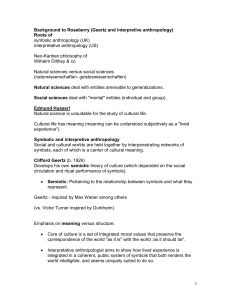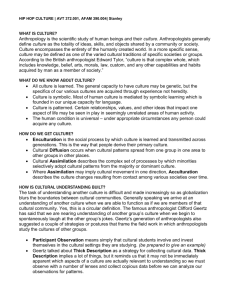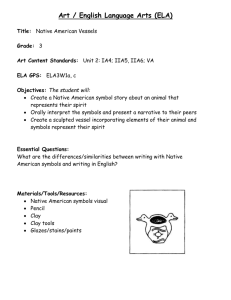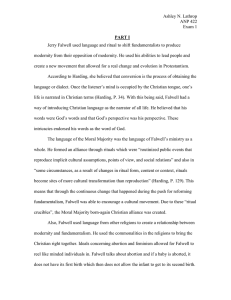Sociology 3301: Sociology of Religion
advertisement
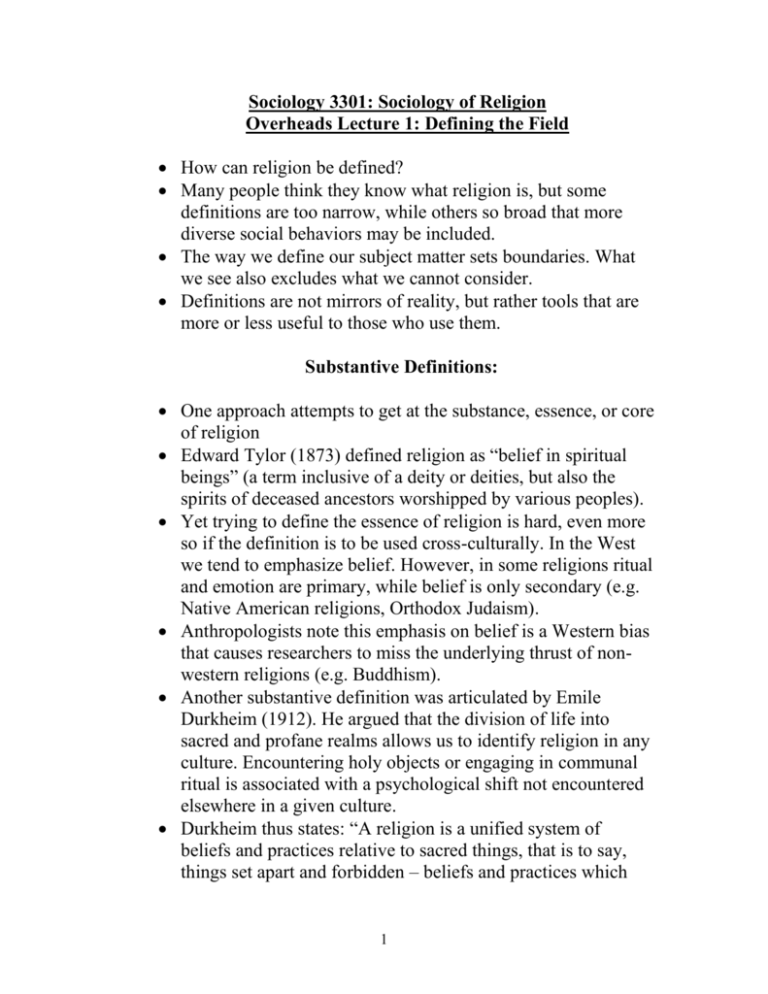
Sociology 3301: Sociology of Religion Overheads Lecture 1: Defining the Field How can religion be defined? Many people think they know what religion is, but some definitions are too narrow, while others so broad that more diverse social behaviors may be included. The way we define our subject matter sets boundaries. What we see also excludes what we cannot consider. Definitions are not mirrors of reality, but rather tools that are more or less useful to those who use them. Substantive Definitions: One approach attempts to get at the substance, essence, or core of religion Edward Tylor (1873) defined religion as “belief in spiritual beings” (a term inclusive of a deity or deities, but also the spirits of deceased ancestors worshipped by various peoples). Yet trying to define the essence of religion is hard, even more so if the definition is to be used cross-culturally. In the West we tend to emphasize belief. However, in some religions ritual and emotion are primary, while belief is only secondary (e.g. Native American religions, Orthodox Judaism). Anthropologists note this emphasis on belief is a Western bias that causes researchers to miss the underlying thrust of nonwestern religions (e.g. Buddhism). Another substantive definition was articulated by Emile Durkheim (1912). He argued that the division of life into sacred and profane realms allows us to identify religion in any culture. Encountering holy objects or engaging in communal ritual is associated with a psychological shift not encountered elsewhere in a given culture. Durkheim thus states: “A religion is a unified system of beliefs and practices relative to sacred things, that is to say, things set apart and forbidden – beliefs and practices which 1 unite into a single moral community called a Church, all those who adhere to them.” Yet those who have used Durkheim’s approach have often implied, even asserted a dualistic worldview, one considering that life has a religious dimension and a non-religious dimension, one sacred, the other profane, that cannot exist in the same time and space. While true that that many people organize their life experience into separate categories, not all do (e.g. the Shakers, the Bruderhof). Greeley (1972) thus argues that any being, social process or value that gives meaning and purpose to life tends to become a source of reverence or profound respect. A sacred attitude is not totally unlike a secular outlook, but involves a matter of intensified respect. This does not exclude the study of nationalism, political ideologies, or any other system of profound loyalty as a form of religion). Such broad views bring us back to one underlying question in this whole debate: whether religion by definition has to include only that which has an otherworldly or supernatural dimension. The major criticism of such substantive definitions is that they tend to focus researcher’s attention solely on traditional forms of religion. Some feel that people in complex and changing societies like ours are religious in new ways. Hence, the old, substantive definitions are too narrow, too tradition bound, blinding us to new forms of religiosity. Functional Definitions: Milton Yinger (1970) changed the question from what a religion is to what it does. He suggests that we define a social phenomenon as religious if it fulfils the conscious and intended functions of religion. 2 He asserted that meaning in life is a basic human need. A fundamental concern of human beings is to understand the purpose of life and the meaning of death, suffering, evil, and injustice. Thus, religion “can be defined as a system of beliefs and practices by means of which a group of people struggles with these ultimate problems of human life.” This definition considerably expands the range of phenomena that we consider under the heading of religion (e.g. nonthesistic, even non-supernatural systems of belief and practice). Yinger argues that employing traditional, narrow definitions of religion may result in misunderstanding and misidentification of religion – particularly in societies undergoing cultural change. Yinger assumes that, to some extent, all people are religious. He writes: “To me, the evidence is decisive: human nature abhors a vacuum in systems of faith. This is not, then, a period of religious decline but is one of religious change.” A second well-known functional definition of religion comes from Robert Bellah (1970). He defines it as “a set of symbolic forms and acts that relate people to the ultimate conditions of their existence.” Both Yinger and Bellah assert that any system of belief and action that fails to address the fundamental questions of meaning in life is not a religion. There are ongoing debates as to whether a supernatural dimension to functional definitions of religion is necessary, proponents arguing that this more clearly separates religion from other social phenomena; opponents that it misses much of importance in a changing society. A Symbolic Definition: Clifford Geertz (1966) developed a symbolic definition of religion that is somewhat more detailed in defining what religion does. 3 Symbols – objects, behaviors, or stories that represent or remind one of something else – are powerful forces in human behavior, and also central to religion. Given the abstract nature of the focal point of religion, symbols serve as an indispensible medium. Various levels of meaning can be communicated through symbols – and they are far more accessible to human observation than a subjective experience of “ultimate concern.” Religious symbols are distinct from non-religious ones in that the former are macro symbols, those that help one interpret the meaning of life itself and involve a cosmology or worldview (e.g. a cross). In contrast, many non-religious symbols are micro symbols, those that affect everyday interaction with other and enhance daily communication and cooperation (e.g. a handshake). Geertz’s definition states that “Religion is: (1) a system of symbols, which acts to (2) establish powerful, persuasive, and long lasting moods and motivations in people, by (3) formulating conceptions of a general order of existence, and (4) clothing these conceptions with such an aura of factuality that the moods and motivations seem uniquely realistic.” There are 3 major challenges that seem to belie the meaningfulness of life and it is these that a religious worldview must resolve: (1) a sense of coherence and reasonableness of events in life; (2) a sense of meaning in suffering so that it becomes sufferable; and (3) a sense of moral order in which evil will be overcome and that virtue, goodness, and justice will somehow, someday prevail. Geertz moved on to consider how a particular worldview or set of concepts comes to be believed, asserting that symbols 4 “act to clothe those conceptions in such an aura of factuality that the moods and motivations seem uniquely realistic.” Geertz also pointed out that religion is able to provide plausibility structures, a foundation for social values that has authority outside of empirical observation and thus cannot – for believers – be invalidated. Values and perspectives come to be shrouded in sacredness and unquestioned certainty. Meanwhile, meaning is commonly stored or encapsulated in symbols, that are powerful factors in people’s lives. These are far more concrete and observable than an “ultimate concern.” Qualitative researchers find Geertz’s definition useful, for it identifies the general properties of religion and what to observe, yet does not specify the content of religious belief. This also suits it to cross cultural work. Quantitative sociologists, however, find his ideas so broad that his identification of religion is not helpful in defining researchable categories. Ultimately, Geertz’s analysis is much more than a definition. It is an essay on how religion works to reinforce itself and on what religion does in society. Hence, his symbolic definition may be considered one type of functional definition. The Concept of Religion to be Employed in this Class: The underlying interest in this course is to consider the ways that people generate and sustain new systems of meaning in the midst of social change. As well, we are interested in how people create their own systems of meaning. Usually, meaning systems involve a synthesis of official religious doctrine with other cultural beliefs. Rather than distinguish religion from non-religion, we will seek to explore anything that provides meaning and purpose in 5 the lives of people. We will ask how people are religious rather than whether they are. Hence, what we will be dealing with throughout the course will be most compatible with the functionalist definitions of Yinger and Geertz, each of whom was interested in religion as a cultural system. We will use the following as a working definition: religion is an interdependent system by which a community of people are bonded: (1) by a shared meaning system (a faith or worldview); (2) by a set of myths (beliefs), rituals and symbol systems that sacralize the meaning system for the members; (3) by a sense of belonging to a reference group; (4) by a system of ethics or values that is directive in the lives of the members; and (5) by a set of routinized social expectations and patterns. Those phenomena in society that have most, but perhaps not all, of these characteristics will be explored as possible “invisible religions” or “quasi-religions” that can impact traditional religion and that may well be emerging as new religions in our society. 6



